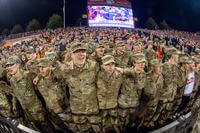We've all made our fair share of mistakes over the years, but when it comes to training for the military, avoiding common blunders is crucial. Whether you're aiming for the conventional military or a career in special operations, there are best practices you should apply to help you achieve the required level of fitness efficiently.
Every recruit faces a critical moment at the beginning of their military career, and the wrong training decision can result in failure or injury. To meet the standards and successfully graduate from your future training, you must address several essential items and avoid mistakes that can hinder your success.
Here are several common mistakes for recruits preparing for military fitness testing, training and continued maintenance of capabilities:
1. Using Generic Programs to Address Specific Needs
Recognize the danger of relying on generic fitness programs. Your training must specifically address the demands of military service, which means tailored workouts that target your unique strengths and weaknesses. Instead of following a one-size-fits-all approach, tailor your regimen to your requirements. You must adjust the generic plan to fit your focused weakness, current abilities, facilities, equipment, goals and time investment each day of the week.
2. Training Only for the Fitness Test
While preparing for the fitness test is important, actual military readiness extends well beyond the test. Understand that tactical fitness requires recruits to "get good at everything." This means adding strength, muscle stamina and endurance training that apply to the real-world demands of military life. Also, shift your focus beyond merely passing the fitness test with the bare minimum standards. That is no way to start your journey. Start to prepare for future events you may see in training, such as swimming, rucking, longer runs and other load-bearing activities.
3. Ignoring Weaknesses Among the Fitness Elements
Doing things we are not good at is one of the more complex changes needed to succeed. Face it, it is not fun to be so bad at running that you must start walking in less than a minute. Assess yourself regularly to see improvement (or not) and determine whether you are on the right track. Identify and confront your weaknesses head-on.
Ignoring areas where you lack proficiency will stop you dead in your tracks of progress. Whether it's cardiovascular endurance, muscle stamina, strength, agility or flexibility, addressing these weaknesses will enhance your overall performance and preparedness. Otherwise, you will have to engage your mental toughness to endure these activities, and that may not be enough to meet or exceed the standards.
4. Not Understanding the Phases of Preparation for Tactical Professions
Familiarize yourself with the distinct phases of tactical fitness preparation required for recruits. Each phase serves a specific purpose in building your fitness foundation, so understanding this progression will optimize your training.
- Phase 1 of Tactical Fitness: Getting to the Training
- Phase 2 of Tactical Fitness: Getting Through the Training
- Phase 3 of Tactical Fitness: Active-Duty Fitness Maintenance
To prepare fully, recruits need ample time in both Phase 1 and Phase 2 of this process. Otherwise, your preparation could be inadequate.
5. Doing Sports-Specific Workouts that You Know from the Past
Step away from older high school or college sports-specific workouts (or even bodybuilding) that may have previously worked for you in the past. Military fitness demands a unique and well-rounded approach, addressing all fitness elements. These include strength, power, speed, agility, muscle stamina, endurance, flexibility, mobility and grip specific to your branch of service and job requirements.
Depending on your choices for service, you could need more time to prepare to become proficient in many of these types of tests and physical events.
6. More is Not Always Better
When things are not going well, we want to add more. If you are a slow runner, add more running. If you are not good at push-ups, do more push-ups. Training is not a linear process of progression. Knowing when to push harder, when to recover and the specific goals to achieve during each training phase can make a significant difference.
While a logical, progressive training program will increase activity regularly, massive jumps in volume will lead to near-immediate pain, usually in the form of shin splints, tendinitis or worse. Believe it or not, less can be better if you are training hard. Take a few days and drop the intensity, de-load and recover. Performance will often improve, and you will feel better after proper recovery. Here are seven ways less is more when it comes to military fitness.
Avoid these mistakes and prepare thoroughly. This is your moment to sharpen your focus and train smarter, not harder. Dive into expert insights on fitness preparation at Military.com Fitness Section. Step into military service with confidence. Thank you for considering military service. Now get ready to do it well.
Want to Learn More About Military Life?
Whether you're thinking of joining the military, looking for fitness and basic training tips, or keeping up with military life and benefits, Military.com has you covered. Subscribe to Military.com to have military news, updates and resources delivered directly to your inbox.


















